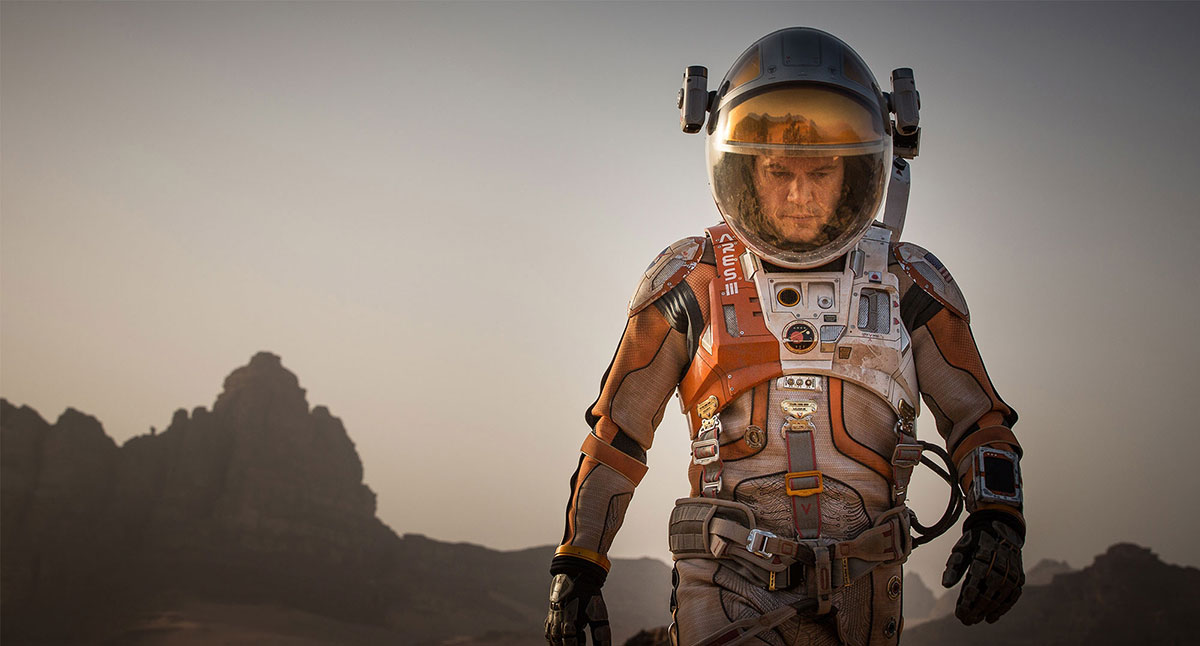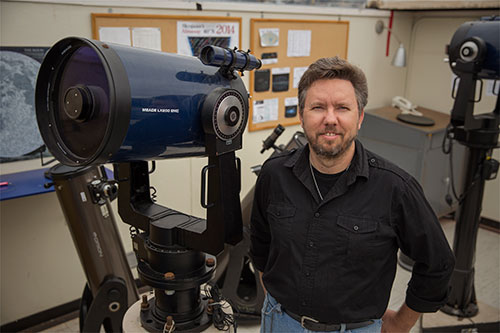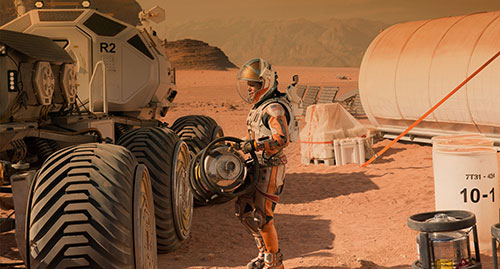Physics and astronomy professor on five surprising facts about 'The Martian'

Still from "The Martian" by photographer Aidan Monaghan for 20th Century Fox.
“Whenever I discover a new planet” is a bold way to begin a conversation. But San Francisco State University Assistant Professor of Physics and Astronomy Stephen Kane isn’t afraid to be bold -- he has discovered more than 150 planets in the roughly 20 years he’s studied extra-solar planets (those orbiting stars other than the sun).
“Whenever I discover a new planet, people ask questions like, ‘How far away is it?’ and the subtext is, ‘How soon can I get there?’” he continued.
When it comes to extra-solar planets, the outlook is bleak. “It’ll be tens of thousands of years,” Kane said. “Then we focus on planets in our solar system; what can we do on Venus, on Mars, on the moon? That’s what 'The Martian' explores.”

Professor Stephen Kane looks toward the final frontier in his SF State astronomy lab.
"The Martian," a new film based on a novel of the same name, was released Oct. 2. The movie takes place in the 2030s as a crew of NASA astronauts heads to Mars to conduct research. When a dust storm lashes out from the planet’s sandy surface, astronaut Mark Watney (played by Matt Damon) is swept away and presumed dead by his crew, which evacuates Mars in the storm’s chaos. Watney, still alive and abandoned on Mars, struggles against the planet’s hostile environment to survive until a rescue mission can bring him back to Earth.
Below, Kane evaluates the ways in which the science in "The Martian" was, and was not, accurate in its depiction of space travel and life on another planet in the near future.
Warning: contains light spoilers.
1. Sending humans to Mars could be possible within the next 20 years
Kane asserts that human arrival on Mars, either for a short-term visit or to begin building a colony, is a possibility by the 2030s.
“Passing through the technological barriers in the way of traveling to Mars is definitely feasible,” he said. “Usually the obstacles we face are economic in nature -- essentially it’s a lack of funding that’s preventing humans from getting to Mars.”
2. "The Martian" is highly scientifically accurate…
According to Kane, "The Martian" author Andy Weir paid fastidious attention to the science in both the book and film version of his story. He commends Weir on his portrayal of a realistic timeline for back-and-forth travel to Mars, as well as for his calculations on how Watney could survive on Mars.
“Watney figures out how much dirt he needs in the habitat to grow potatoes, how many liters of water he needs to make the ground fertile, how many days he needs to survive before he can ostensibly get more supplies from NASA,” Kane explained. “After reading the book I wondered how it would avoid coming across as a two-and-a-half hour physics lecture, but it struck a great balance. The level of detail is astonishing but not to the point that it’s difficult to follow.”
3. …Except for one part
Kane says that Weir’s only major point of scientific inaccuracy takes place in the beginning of the film -- but the professor deems it an acceptable lapse, as Weir knowingly took poetic license to further the story’s plot.
“The only part where the science is incorrect -- and Weir is aware of this -- is actually what sets up the whole movie,” Kane said. “Weir was interested in a man-versus-nature theme and survival in Mars’s extreme environment. So early in the movie a dust storm wreaks havoc on the crew and their equipment, which is how Watney ends up stranded.

Still from "The Martian" by photographer Giles Keyte for 20th Century Fox
“In actuality, the atmospheric pressure on Mars is extremely low, much lower than on Earth. Although you can get high wind speeds, the pressure that it pushes against you is not enough to cause the destruction portrayed in that movie.”
4. Mars is more distant than most people think.
After a lifetime of looking at the solar system on computer screens, science fair posters and shoebox dioramas, it’s easy to forget just how massive it is. And the solar system is just one small part of the known universe.
“Mars is our nearest planetary neighbor, but when you talk about getting there, you're talking about a six-to-nine-month journey,” Kane described. “It would take a lot of careful planning to organize a mission to Mars, as a spacecraft would have to leave Earth at the right point in its orbit around the sun while Mars is also at a relatively close position in its own orbit. The return would have to be planned the same way.
“Astronauts have a small launch window during which to travel to the destination site. If the weather is bad during the launch window, a NASA crew might have to wait an entire year before it can try again.”
5. A "gravity assist" is a real thing.
The movie involves astronauts on the NASA spacecraft Hermes attempting something called a gravity assist -- a trip around a planet in the direction in which it’s rotating -- to get an energy boost. Kane says this is both a real maneuver in space travel and that it's accurately represented in "The Martian."
“In the film,” Kane said, “the Hermes crew is on the way back to Earth when they realize that returning to Earth and then launching for Mars to get supplies to Watney will take too long. Instead, they arrange to travel around Earth using the planet’s gravitational field to propel the Hermes back toward Mars. This helps the crew save on both time and fuel.”
***
Despite some of the science in "The Martian" seeming a bit complicated, Kane posits that even viewers who are not astrophysicists and/or who have not discovered more than 100 planets can enjoy the film.
“It was very good,” he commented. “I went with my young daughters and they also appreciated it.”